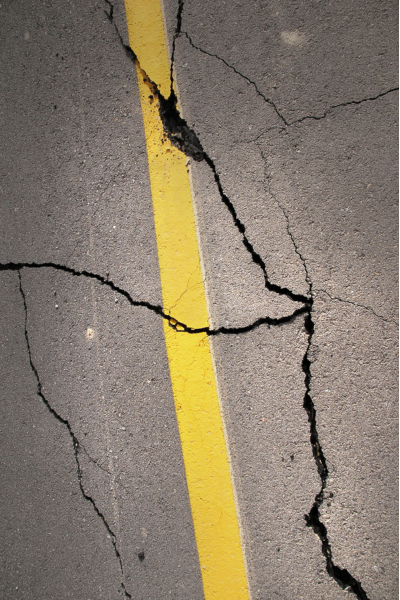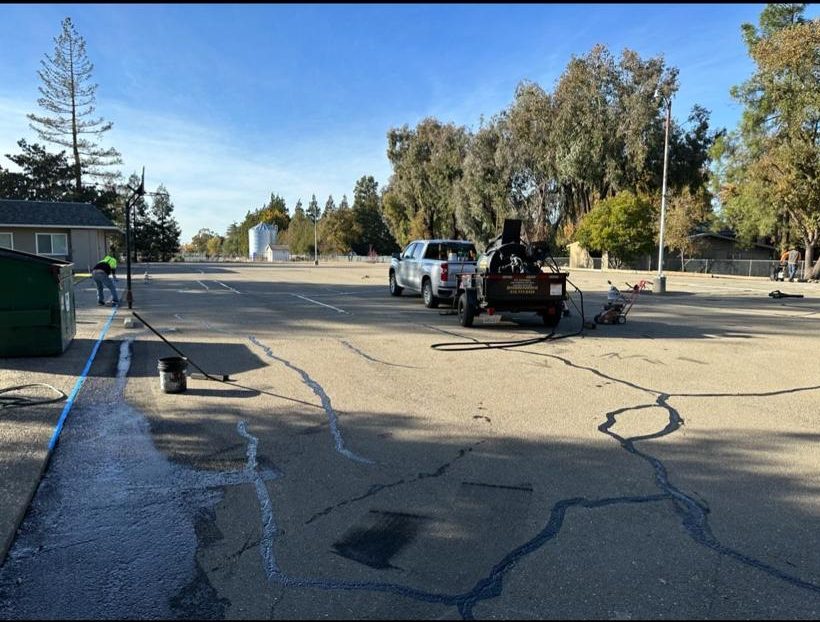- 415-774-6424
- htpavingco@yahoo.com
- License Number: 1112332
Asphalt Crack Filling
Asphalt Crack Filling - Protect & Preserve Pavements
Have you ever wondered how to protect and preserve pavements from cracking? Did you know that asphalt crack filling can be the solution you’ve been looking for? Discover the key benefits and techniques of this maintenance practice that can help extend the lifespan of driveways and parking lots.
Key Takeaways:
- Asphalt crack filling is essential for preventing further damage and degradation caused by moisture, chemicals, and weathering.
- By sealing cracks, you can avoid costly repairs and extend the lifespan of pavements.
- Benefits of asphalt crack filling include preventing the growth of vegetation, reducing tripping hazards, and enhancing the aesthetic appeal of pavements.
- HT Paving and Seal Coating is a trusted asphalt maintenance contractor offering expert services in crack filling and other maintenance practices.
- Professional asphalt crack repair involves a step-by-step process, including thorough cleaning, proper preparation, and the use of specialized equipment.

The Importance of Asphalt Crack Filling for Pavement Longevity
Asphalt crack filling is a critical component of pavement maintenance that significantly contributes to the longevity of pavements. By addressing and sealing cracks in asphalt surfaces, it becomes possible to prevent further damage and deterioration caused by various factors such as moisture, chemicals, and weathering. This preventive measure not only helps avoid costly repairs but also extends the lifespan of driveways and parking lots, ensuring they remain in optimal condition for an extended period of time.
One of the primary benefits of asphalt crack filling is its ability to prevent water from seeping into the underlying layers. Water intrusion can cause significant damage to the structural integrity of asphalt surfaces, leading to potholes, depressions, and other substantial issues. By sealing the cracks, the risk of water infiltration is minimized, preserving the integrity of the pavement and preventing further deterioration.
In addition to preventing water damage, asphalt crack filling also offers several other advantages. It helps prevent the growth of vegetation within the cracks, reducing the need for frequent weed removal and enhancing the overall aesthetic appeal of the pavement. By maintaining a smooth and intact surface, crack filling ensures the safety of both vehicles and pedestrians by minimizing tripping hazards. Furthermore, regular crack filling as part of driveway maintenance routines helps to maintain a visually pleasing and well-maintained appearance.
In summary, the importance of asphalt crack filling for pavement longevity cannot be overstated. This maintenance practice provides multiple benefits, including the prevention of further damage, the enhancement of visual appeal, and the avoidance of costly repairs. By investing in asphalt crack filling, property owners can protect and preserve their pavements, ensuring their longevity and maximizing their value.
HT Paving and Seal Coating: Your Expert Asphalt Maintenance Contractor
When it comes to asphalt crack filling or asphalt maintenance, HT Paving and Seal Coating are the experts you can trust. With years of experience in the industry, they specialize in providing high-quality asphalt maintenance services. Whether you need crack filling, seal coating, or pavement repairs, HT Paving and Seal Coating have got you covered.
Their team of skilled professionals is knowledgeable in the latest techniques and uses top-of-the-line equipment and materials to ensure durable and long-lasting results. They understand the importance of proper asphalt maintenance and are committed to delivering exceptional service to their clients.
When you choose HT Paving and Seal Coating, you can have peace of mind knowing that your asphalt surfaces are in good hands. Their expertise, attention to detail, and commitment to customer satisfaction set them apart as the go-to asphalt maintenance contractor in the industry.
Step-by-Step Guide to Professional Asphalt Crack Repair
Professional asphalt crack repair involves a systematic process to ensure effective and long-lasting results. The following steps outline the recommended crack repair process:
Step 1: Thoroughly Clean the Cracks
The first step is to clean the cracks thoroughly to remove any debris or vegetation that may be present. This can be done using a broom, brush, or compressed air to ensure a clean surface for the crack repair.
Step 2: Prepare the Cracks
Next, the cracks need to be prepared by creating a clean and smooth surface that allows for proper adhesion of the crack filler. This can be achieved by removing loose asphalt, using a wire brush to clean the cracks, and ensuring that any remaining debris is removed.
Step 3: Apply the Crack Filler
Once the cracks are prepared, it is time to apply the crack filler. Using specialized equipment such as a crack fill applicator, the filler is applied, ensuring that it penetrates deeply into the crack. This ensures a complete and effective repair.
Step 4: Remove Excess Filler
After the crack filler is applied, it is important to remove any excess filler to ensure a level surface. This can be done using a scraper or squeegee, carefully removing the excess material without disturbing the repaired area.
Step 5: Allow for Curing Time
It is crucial to follow the manufacturer’s instructions and allow sufficient time for the crack filler to cure before allowing traffic on the repaired area. This ensures that the repair is properly hardened and ready for use.
By following these step-by-step guidelines, professional asphalt crack repair can be performed effectively, resulting in a durable and long-lasting solution. This process helps to prevent further damage and deterioration, prolonging the lifespan of the pavement and maintaining its structural integrity.
Asphalt Crack Filling Techniques and Preventative Measures
When it comes to asphalt crack filling, different techniques can be employed depending on factors such as climate, severity of cracks, and budget. Three common crack filling techniques are hot pour crack sealing, cold pour crack filling, and asphalt emulsion crack filling. Hot pour crack sealing involves heating a specialized rubberized sealant and applying it to the cracks, creating a durable and watertight seal. Cold pour crack filling utilizes premixed asphalt emulsion that can be applied directly to the cracks without heating. This technique is convenient for small-scale crack repairs. Asphalt emulsion crack filling utilizes an emulsified asphalt mixture that is applied using specialized equipment to penetrate deep into the cracks, providing excellent adhesion and flexibility.
While crack filling is crucial, preventative measures are equally important to avoid future cracks and extend the lifespan of the pavement. Regular inspections should be conducted to identify any existing or potential cracks. Timely repairs of small cracks can prevent them from expanding and causing more significant damage. Seal coating the surface creates an additional layer of protection against the harmful effects of UV rays, chemicals, and moisture. Proper drainage ensures that water does not accumulate on the pavement, preventing it from seeping into cracks and causing deterioration. Regular maintenance, including sweeping and cleaning, helps address any potential issues before they worsen and become more costly to repair.
By combining effective asphalt crack filling techniques with preventative measures, property owners can protect their pavements from further damage and significantly extend their lifespan. Implementing these best practices ensures that your asphalt surfaces remain safe, durable, and visually appealing for years to come.
WHAT IS IT?
“Asphalt Crack filling” refers to the process of filling or sealing cracks or fissures in a paved surface, such as a road, highway, parking lot, or sidewalk. This procedure is carried out to prevent existing cracks from widening over time due to exposure to the elements and traffic, which could lead to more serious issues with the paved surface.
Repairing asphalt pavement is often necessary due to natural wear and tear over time and damage caused by factors such as traffic, weather conditions, tree roots, water leaks, and other external agents. Asphalt patches are specific areas where damaged or deteriorated asphalt is removed and replaced to restore the surface to its original condition.
Steps of crack filling
Crack filling is typically done using a sealing material, which may be an asphalt-based compound or a similar substance. The process involves the following steps:
1.
Cleaning the crack
Before applying the sealer, it’s important to clean the crack of any dirt, debris, or moisture that may be present. This ensures better adhesion of the sealer to the crack’s walls.
2.
Preparation of the sealer
The sealing material is prepared according to the manufacturer’s specifications. It can be in liquid form or solid form, depending on the type of sealer used.
3.
Application of the sealer
The sealer is poured or applied into the crack to fill it completely. It can be applied hot or cold, depending on the type of sealer and the surface conditions.
4.
Compaction and smoothing
After applying the sealer, a suitable tool, such as a trowel or squeegee, may be used to compact the material and smooth the surface. This ensures that the sealer adheres well and that the crack is level with the surrounding surface
Crack filling is an important maintenance measure to extend the lifespan of paved surfaces and prevent more significant damage. By sealing existing cracks, it prevents water and other elements from penetrating into the pavement’s base and causing additional damage, such as pothole formation. This helps maintain the structural integrity of the surface and reduces long-term repair costs.
Need A Free Estimate?
Contact us today to schedule a free consultation and discuss your project in the Bay Area, California. Our team is ready to provide you with top-quality service.

